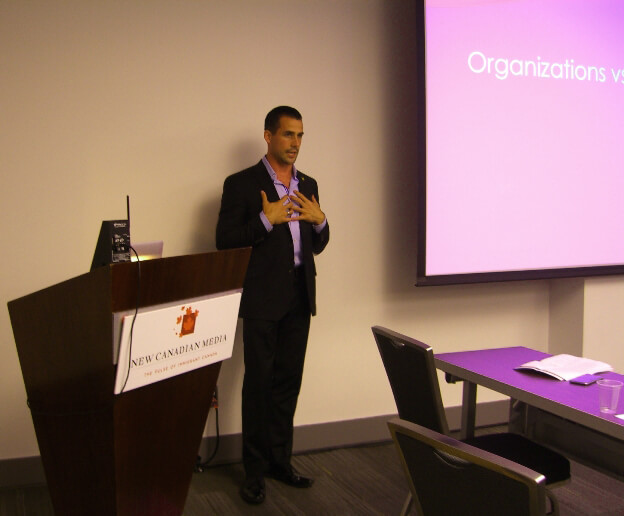Getting the mainstream media to cover more immigrant issues is something many settlement and advocacy agencies grapple with.
The first of a series of workshops presented by New Canadian Media, a two-hour interactive session entitled “Increasing the Visibility of the Immigrant Service Sector” aimed at addressing this challenge.
The participants – mostly employed as executive directors and communications officers by non-profit settlement and advocacy organizations – were there by invitation to learn how to project their messages to the wider Canadian public, and particularly to the decision-makers who allocate government grants and corporate donations.
“I’m 60, white and male, and my newsroom is filled with people like me,” Ibbitson said. “And I’m not prepared to quit right now.”
One participant said that she was eager to learn from the two high-profile speakers – John Ibbitson, writer at large with the Globe and Mail and Mitchell Kutney, Ottawa blogger and social media expert – because immigration and refugee advocacy groups have been facing multiple challenges in recent years, and there is an urgent need to make them known to all Canadians.
Crack the Fortress of Media Power
Speaking first, Ibbitson introduced the concept of the “Laurentian elite,” which he defined as the small group of media executives, as well as top academics in various fields, who live in the central Canadian provinces of Ontario and Quebec (especially the major cities of Toronto, Ottawa and Montreal) and control the pages and airwaves of the traditional media.
His central point was that one can wait patiently for another 25 years or so for the demise of the Laurentian elite, or one can be proactive in cracking the group’s closely guarded fortress of media power.
Identifying himself and some of his colleagues as members of this elite, he said that they were mostly white, male, middle-aged or older, and shared the same world-view. They are also desperately fighting for their own survival in a tectonic shift of the media and political landscape, he pointed out. That is a critical point to remember when trying to break into their gated territory, he emphasized.
“I’m 60, white and male, and my newsroom is filled with people like me,” Ibbitson said. “And I’m not prepared to quit right now.”
He explained that, because communications technology is changing at a dizzying pace and there is a very real possibility that traditional media may no longer be financially sustainable within the next 10 years, newsrooms are laying off rather than hiring new staff.
This, he pointed out, combined with the prejudice that some new Canadians hold against about pursuing journalistic careers, is a hindrance to changing the demographics of newsrooms.
“We don’t want to ghettoize. The mainstream media is a platform for all Canadians.” – John Ibbitson
Ibbitson cited the example of some brilliant ethnic-minority interns that his newspaper had trained recently, and offered employment to, only to have the opportunity turned down. He speculates this was probably because their immigrant parents disapproved of journalism as a career choice.
Pitch Stories for All Canadians
Regarding the pro-active approach, Ibbitson advised communications professionals to get to know as many journalists as possible, and to pitch stories that fall within the writer’s range of topics and are relevant to all Canadians.
For example, if a country has business opportunities for Canadians, that becomes a relevant story, he said.
On the other hand, as one workshop participant Mohammed Adam, formerly a reporter and now a columnist with the Ottawa Citizen, said: “People used to ask me to write about some country that Canadians have no interest in at all, and my editors wouldn’t go for it.”
Ibbitson said a pitch that would help the beleaguered media industry attract readers/viewers would get a positive response, because there was a definite alignment of interests there. He also elaborated on the increasing importance of business news, pointing out that all of the Globe and Mail’s foreign bureaus concentrate on business.
Share meaningful content, especially with media. Original content that adds to an existing conversation ensures the greatest uptake.
“Why should we pitch or reach out to you?” asked one of the workshop participants.
“We don’t want to ghettoize. The mainstream media is a platform for all Canadians,” Ibbitson replied. Another reason is that the people who give out funds to immigrant-serving organizations read newspapers like the Globe, he added.

Ride the Social Media Wave
Mitchell Kutney (pictured at right), the workshop’s other featured speaker, is an established Ottawa-based blogger who covers topics related to social enterprise, charity and philanthropy. With over 100,000 followers, he is one of Ottawa’s 10 most highly followed Twitter users.
Kutney’s fast-paced presentation focused on harnessing the incredible potential of Twitter for reaching people outside of one’s “social capital” or usual network of contacts, as well as for securing the attention of key people in the mainstream media.
Some practical tips he gave the audience were:
- Use analytics to discover the peak times for reaching the targeted readership. These tend to be 8 a.m., 4 p.m. and 9 p.m.
- Share meaningful content, especially with media. Original content that adds to an existing conversation ensures the greatest uptake.
- Use hashtags in the tweet that have an established following.
- Follow new accounts that have expressed an interest in similar content.
- Engage with other Twitter users by retweeting, replying to and “favouriting” selected tweets.
- Accounts with fewer than 2,000 followers should be following about 1,000 to 1,500 accounts a month.
Asked about the secret of his large following, Kutney said: “I invest an incredible amount of time on my blog and Twitter account and write about controversial topics.”
Ottawa-based writer/journalist, editor, blogger, communications professional seeking freelance opportunities in political and travel writing.




